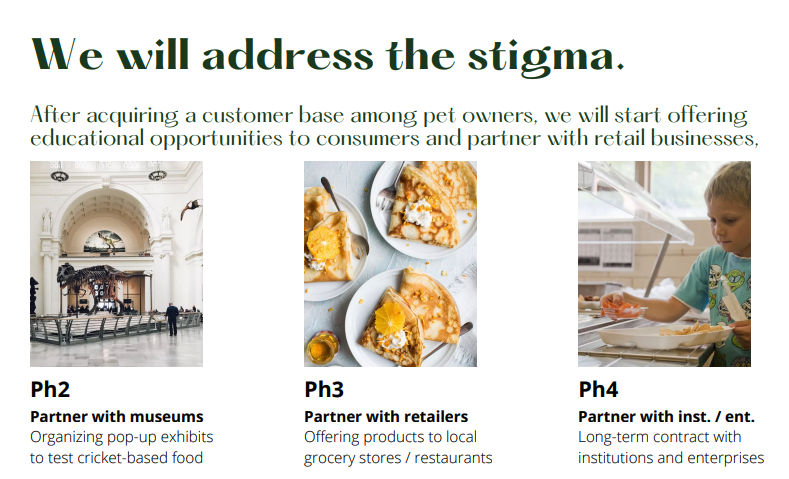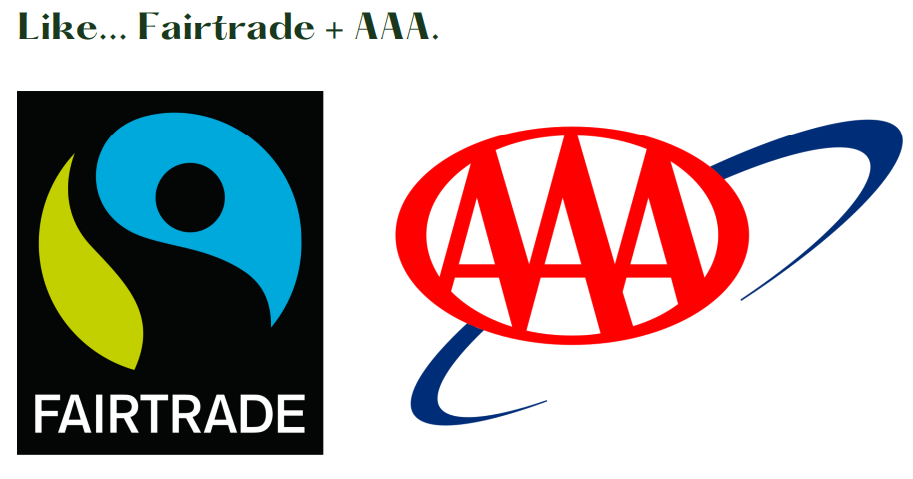How might design methods be used to inform long-term agricultural investment decisions?
The Challenge
How might we identify the most promising opportunities for long-term infrastructure investments in the realm of controlled environment agriculture (CEA)?
The Solution
After four rounds of prototyping, we created a vision and set of design principles to guide investment decisions for CEAs. We then identified two projects to develop further, which we outlined in our final report and presentation to a public audience.
The Impact
Our work validated the hypothesis that design approaches can bring unique value to investment decisions. This opens up a wide range of exciting possibilities for future collaboration between designers and investors.
Time: 15 weeks, Spring 2023
Sector: Capital investment
External project partner: Jordan Ostapchuk, PhD student at Institute of Design and Vice President of Strategy and Innovation at OMERS, one of Canada’s largest public pension funds
My role: Design researcher + strategist, lead report writer
Services:
Research through prototyping
Future-state analysis
Insight discovery
Storytelling
What makes this project unique?
First, using design methods in an investment context is unique; this approach allowed investors to explore investment opportunities much more broadly and holistically than using investment methods alone. Second, instead of a more traditional design research approach, we used prototyping to research and explore the future of agricultural infrastructure. The integrity of physical prototyping helped us test out our ideas quickly and identify the most promising opportunities. Lastly, our prototypes were entire systems, rather than discrete products; this meant we had to think holistically and use rigorous methodologies to ensure all the parts of the system made sense together.
Reach more about this approach and our professor Carlos Teixeira’s innovative approach to systems design here.
1. Challenge
The need for a new agricultural system The agricultural systems of the 20th century are not designed for the 21st century. Growing social inequality, surging global populations and the increasing impacts of climate change threaten the fragile, extractive infrastructures that produce the majority of the world's food. Our task as a team was to explore how this global context, as well as the growing forces of decentralization, digitization and decarbonization ("the 3 Ds") will shape food infrastructures of the future. We then determined which infrastructures had the most potential for long-term infrastructure investment by a public pension company like OMERS.
What is a CEA? Any system in which growers use technology to monitor and optimize the conditions for growing crops. Greenhouses, aquacultures, hydroponic farms, and vertical farms are all examples of CEAs. When viewed through an investable infrastructure lens, CEAs may also involve the production of agricultural products, as well as the post-production supply chain and the beginning of the food manufacturing process. Especially as technologies continue to improve, CEAs offer a tremendous opportunity for increasing the efficiency, sustainability and reliability of global agricultural systems.
What is investable infrastructure? The decisions that investors make about how to distribute and invest their financial resources are a major force shaping the future. When determining where to invest, infrastructure investing is a uniquely exciting opportunity in that it can be more innovative than more traditional forms of investing but not as risky as tech investing. As designers, our skills are best leveraged by exploring future opportunities for investable infrastructure. Similar to an architect exploring all possible configurations for houses of the future, designers can explore all the possibilities for future infrastructures and identify which ones are most compelling. Then, designers give this specific list of criteria to investors, who act like real estate agents and search for these particular types of homes that they would otherwise not have known could be built if not for their collaboration with designers.
Investable = fixed assets that contract long term cash flow
+
Infrastructure = decarbonized, digitized, decentralized durable systems
2. Research + Insights
Prototyping process

For each prototype, we created very specific scenarios in order to identify how individuals, technologies and policies would come together in real life. In this picture I am describing a scenario in which a greenhouse worker is troubleshooting the automation function during a power outage.

Our first physical prototype of a compost-for-food exchange service in Phoenix, Arizona. Note the arduino-powered sensing to optimize growing conditions, distributed network of greenhouses around the city and the compost-for-food exchange program.

We also relied heavily on visual thinking to sketch out how each prototype would exist within larger systems.

Our team used a variety of tools, including Arduinos and Legos, to understand the specifics of the CEAs we envisioned.

The anatomy of infrastructure framework helped us think systematically about each component of the systems we were creating.

We also relied heavily upon team discussions to deepen our thinking. In this photo, we are clarifying how the insect protein infrastructure works.
10 opportunity areas identified
Centering food production closer to population centers
Prioritizing animal welfare in protein production
Scaling the production of sustainable proteins
Building AI tools to inform farmers’ DEI and sustainability decisions
Leveraging data to increase food production efficiency
Implementing nutrient exchange services
Reusing existing infrastructures
Building mobile and modular CEAs
Creating a global network of digitally connected CEAs
3 design principles
Any CEA infrastructure we propose must move from:
Narrow default mindsets around food to… expanded food mindsets
Centralized black box sites of production to… resilient, decentralized networks
Decisions driven only by profit to… values-driven decision-making processes
2 final prototypes
Sustainable Superfood: activating the potential of edible insects
Agro Alliance: a resiliency-building network for farmers
3. Solutions
Prototype 1: Sustainable Superfood
The opportunity: The edible insects market is projected to be a $9.6 billion market by 2030.
The growth of the edible insects market is driven by the increasing greenhouse gas emissions from the livestock and poultry industries, the high nutritional value of insects, the environmental benefits of consuming edible insects, the rising demand for insect-derived protein in the animal feed industry, and the minimal risk of transmitting zoonotic diseases with the consumption of edible insects. Furthermore, emerging economies are expected to provide significant growth opportunities for the players operating in this market. However, a lack of awareness regarding the benefits of insect consumption is expected to remain a major challenge for the growth of this market. We envision a system of CEAs that work together to produce insect protein at scale. This system has five important features that make it an investable infrastructure:
Prioritized Fulfillment & Delivery: Customer orders are prioritized for processing and delivery based on an equity score that are assigned at sign up.
Workforce Development: Employment opportunities for formerly incarcerated people is prioritized to provide job training in the managements of CEAs.
Data into Intelligence: Both the processing of orders, as well as the environmental and health conditions of the insects are monitored & maintained for optimal results through automation.
Insect Protein: The CEA is used for the production and processing of insect to produce a more sustainable protein that has a range of consumer markets, including animal food companies, protein powder suppliers and restaurants.
Humane On-Site Processing: The CEA system performs an end-to-end service; insects are grown, humanely harvested (a two step method of cooling to induce hibernation, and freezing), and processed into powder for final purchase.
Prototype 2: Agro Alliance
The opportunity: Building more just and resilient networks for specialty crops.
Although many people around the world enjoy eating avocados, far fewer are aware of the many challenges in the avocado supply chain. For example, many avocado growers in Mexico are extorted by criminals who seek to take advantage of this highly concentrated and lucrative industry. The economic pressure to meet selling quotas combined with low formal political authority puts growers in a marginalized position. In situations like this, as well as in cases of environmental disaster (which will become increasingly common due to climate change), farmers need services that will provide them with financial security, emergency services and cooperative networks of other growers who can cover their production needs when their farms are out of commission. Agro Alliance is a global CEA-based network that provides farmers of speciality crops (e.g. avocados, cacao, coffee beans) with these specialized services. The features that make it an investable infrastructure are:
Global Network of CEAs: The global network allows Agro Alliance to respond to incidents from farmers and cover their crop production needs; for instance, when one farmer is unable to produce due to natural disasters or extortion, CEAs in other areas are able to cover their production quotas until they are ready to grow again.
Financial Security for Farmers: Like insurance, farmers are guaranteed a basic income in the face of a crisis that debilitates production of crops on their farm.
Emergency Relief Services: When emergencies strike, farmers receive immediate basic needs relief as well as other longer-term post-disaster supports.
Consumer Education: Consumers learn about the wellbeing of the farmers in their supply chain via QR code stickers. This creates a larger market for ethically-grown crops and systems that holistically support farmers.
Grower Safety through Data Aggregation: Data on conditions is gathered from farmers, NGOs and satellites in order to create a clear, multi-dimensional picture of the current climate as well as predict future trends and dangers. This is more accurate than data only gathered from a single source and creates a holistic picture of what’s happening on the ground, allowing for improved predictive capabilities.
4. Impact

Client Impact
OMERS and our academic advisors were able to validate their hypothesis that design methods can in fact bring tremendous value to long-term infrastructure investing decisions.
Personal Impact & Learnings
I left this project excited about the synergy between design and investing. Marrying the strengths of design (exploring and identifying desirable futures in a risk-free way) with the strengths of investing (having the capital to make those futures a reality) seems to me an exciting recipe for creating more vital, thriving futures.
I really loved exploring new tools for systems thinking through this project, especially the Anatomy of Infrastructure and Action Situation frameworks. Although future projects likely won’t allow the same imaginative freedom as this one, I can still envision using these tools any time I’m looking for intervention opportunities within a larger system.
Team
Team: Anahita Dasgupta, Emery Donovan, Sunaina Kuhn, Yong Hee Yoo, Ran Konaka and Jorge Martinez Arana
Advisors: Carlos Teixeira, Jordan Ostapchuk and Deaa Bataineh

























